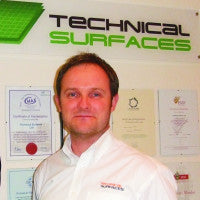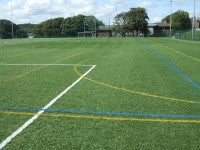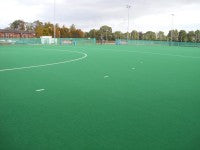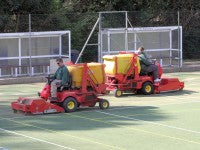Artificial pitch maintenance - when it should be undertaken
 The warm, dry weather conditions of summer make this an ideal time of year to perform certain maintenance tasks on artificial sports pitches. As the seasons seem to shift year to year, this window of opportunity becomes smaller and smaller, and unfortunately the appeal of round-the-clock usage that comes with an artificial pitch often restricts the time that is dedicated to such works, with potential consequences for a pitch's playing quality during the later autumn and winter months.
The warm, dry weather conditions of summer make this an ideal time of year to perform certain maintenance tasks on artificial sports pitches. As the seasons seem to shift year to year, this window of opportunity becomes smaller and smaller, and unfortunately the appeal of round-the-clock usage that comes with an artificial pitch often restricts the time that is dedicated to such works, with potential consequences for a pitch's playing quality during the later autumn and winter months.
Here, Nick Harris of Technical Surfaces Ltd outlines some of the works that can - and should - be completed during warm, dry weather, and why the temptation to sacrifice maintenance time for bookings during the busy summer months could impact on your artificial pitch's performance characteristics when the winter weather sets in.
First of all, it is important to stress that the vast majority of artificial pitch maintenance work can be completed throughout the year. Regular sweeping, for example, is a year-round requirement and should be carried out at regular, repeated intervals to ensure consistency in a pitch's safety and performance levels. There are, however, certain procedures which require dry weather conditions and, as such, should be scheduled in advance into a pitch's annual maintenance programme.
A refreshing of painted line markings and a deep-clean of the top layer of granular infill are two examples of such processes that should only be completed on artificial sports pitches in periods of sustained dry weather, and are usually fulfilled between April and September each year. Both are important elements of an effective maintenance programme and can make all the difference to the amount of revenue that can be generated from an artificial sports facility.
Many artificial pitches are installed as multi-use facilities and are, therefore, utilised by schools and local communities to their fullest potential.
 A pitch can be separated into halves, thirds or quarters, with dividing netting and the application of additional markings, e.g. for five-a-side football or hockey 7s. New markings may also be required with changes in the rules of a sport, to ensure the pitch can host matches at a certain level. A recent example of this is the introduction, in hockey, of a broken 5m line, outside the circle, to assist with the taking of a 'free hit'.
A pitch can be separated into halves, thirds or quarters, with dividing netting and the application of additional markings, e.g. for five-a-side football or hockey 7s. New markings may also be required with changes in the rules of a sport, to ensure the pitch can host matches at a certain level. A recent example of this is the introduction, in hockey, of a broken 5m line, outside the circle, to assist with the taking of a 'free hit'.
There are a number of options when it comes to selecting painted lines for your surface - the use of aerosols can provide pitch markings on a temporary basis (around four weeks) although, if used over a longer period of time, the lines may start to detract from the playability and enjoyment of the sport, as the aerosol paints leach and fade. Excessive build-up of aerosol paint can also contaminate the infill and cause the area around the lines to become a hazard.
An alternative to aerosols is the specialist 2-PAC sports compound - an effective, semi-permanent material applied using an airless spraying technique to produce clearly defined, accurate lines that allow around twelve months' use.
There have also been developments recently in the use of water-based paints, which have demonstrated a similar longevity to the 2-PAC compounds, and have certainly proven to be a good solution for short-term, seasonal requirements such as tennis court markings.

Increased revenue can be generated by adding extra play lines to an artificial pitch but, by its very nature, linemarking is highly weather-dependent, so there is only a limited window of opportunity each year to carry out this work. Attempting to complete linemarking when it is raining is a futile exercise, as the paint will inevitably bleed. Even if it is not raining, pitches generally hold more water during winter - particularly with morning frosts and reduced hours of daylight - and, consequently, paint cannot dry or adhere to the carpet fibres.
Exactly how long painted lines will last on an artificial pitch is dependent on a number of factors, including the amount and type of use the pitch receives, prevailing weather conditions, maintenance routines in place on the surface and the type of footwear worn by players. As a rule, it is worth making provisions to have this work completed annually by a specialist contractor during spring/summer.
Summer is also the best time of year for an artificial pitch to benefit from a deeper clean. When dry, it is easier to penetrate the top layer (usually the top 5-10mm) of infill. This procedure can help to enhance performance levels over a longer period of time, by halting the spread of contamination within the surface infill. An infill clogged with contaminants (e.g. decomposed leaves, vegetation, dirt and debris) causes a pitch's drainage capabilities to slow down, as well as leaving the surface feeling hard underfoot, which affects playing qualities such as ball roll and bounce.
Surface contamination can be identified by the presence of dark patches or areas of silt on the surface, and can be remedied (and even avoided, with best practice) with an annual deep-clean by a maintenance contractor. Such processes use specialist machinery to agitate the surface to decompact the infill, separating contaminants from the infill before removing them from the surface, whilst simultaneously helping to lift the carpet fibres that flatten over time during play.
If required, infill levels should ideally be improved following a deep-clean, as carpet fibres that are well-supported by an adequate granular infill are less susceptible to wear and also help to provide a good quality playing surface. To achieve the best results and ensure an effective separation of contaminants, conditions must be as dry as possible and, again, this type of process is generally carried out from April to September.

In our experience, feedback from players following this procedure has proved extremely favourable, with reports of enhanced playability, restoration of shock-absorbing qualities and improved drainage, all of which, we know, go a long way towards extending the usable life of an artificial sports pitch.
My company is, at present, undertaking scientific testing, in conjunction with Loughborough University, to quantify and evaluate these improvements to demonstrate the full tangible benefits of this procedure.
The labour-intensive nature of this work inevitably requires increased manpower and bespoke machinery, and can take anything up to ten man days to complete (in cases where little or no maintenance has been completed). Understandably, minimising downtime and disruption is of paramount importance to the owners and operators of busy artificial sports pitches and, for that reason, specialist companies will help to minimise disruption by employing multiple machines and drivers per pitch. This ensures that specialist work is completed in a fraction of the time, and also in the small window of opportunity afforded by the British weather.
Facility managers should understand the necessity to dedicate sufficient time to the maintenance of these surfaces, in order to avoid potentially lengthy periods of closure further down the line. As the saying goes, prevention is better than the cure, and a preventative measure can help to keep contamination levels low for as long as possible, delaying the need to replace the granular infill altogether.
 Unfortunately, there is reluctance amongst some facility owners and operators to countenance any period of downtime on their artificial pitches during the summer months and, for as long as the symptoms of a contaminated surface (e.g. pools of standing water) do not present themselves, problems will continue to remain dormant, undetected and unaddressed. However, a pitch inspection by a qualified industry specialist can promptly identify such issues and, if attended to at an early stage, contamination levels can be addressed effectively, less invasively and less costly than if left to develop further.
Unfortunately, there is reluctance amongst some facility owners and operators to countenance any period of downtime on their artificial pitches during the summer months and, for as long as the symptoms of a contaminated surface (e.g. pools of standing water) do not present themselves, problems will continue to remain dormant, undetected and unaddressed. However, a pitch inspection by a qualified industry specialist can promptly identify such issues and, if attended to at an early stage, contamination levels can be addressed effectively, less invasively and less costly than if left to develop further.
For many natural grass pitches, summer is a time to repair, restore and perhaps even relay turf ready for the next academic year or football season. Maintenance practices including scarification, irrigation and surface aeration, combined with tasks such as seeding, soil replacement and the application of topdressing, help to improve the drainage, playing conditions and overall quality of a natural grass pitch. Crucially, the summer 'close season' provides a decent period of time for natural surfaces to recover.
Artificial sports pitches, by contrast, are expected to provide a quality playing surface, if not all year round, then certainly for the vast majority of the year. A key benefit of an artificial pitch is its capacity to support increased usage levels - in the case of some school-leisure centre partnerships and community facilities an artificial pitch can be in use for at least forty-five hours a week.
And, unlike the many natural grass pitches that are afforded a period of inactivity during the summer months, artificial pitches are often in even greater demand in July and August, playing host to various school holiday activities, as well as continuous football coaching and training sessions. But, it is crucial to dedicate sufficient time to maintenance both during and at the end of a playing season, even on the rare occasions when a pitch remains unused during school holidays.
Artificial pitches are still - mistakenly - believed, by some, to be virtually maintenance-free. Their direct appeal lies in the dual benefit of increased usage and potential revenues but, to realise these benefits, the value of maintenance cannot be overlooked. It is important that maintenance is recognised as an annual commitment that is central to the longevity of an artificial sports pitch and, as tempting as it may be, it should not be postponed or ignored during the summer, sacrificed to either save funds or allow for increased usage.
To avoid disruption and, where possible, arrange your summer schedule of works in advance with your maintenance provider. You can then plan ahead for the autumn and winter months, safe in the knowledge that your artificial sports pitch is fully prepared.
